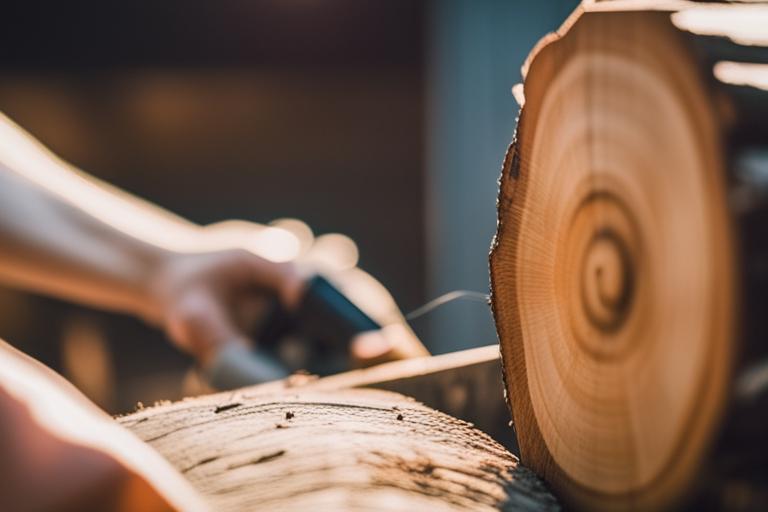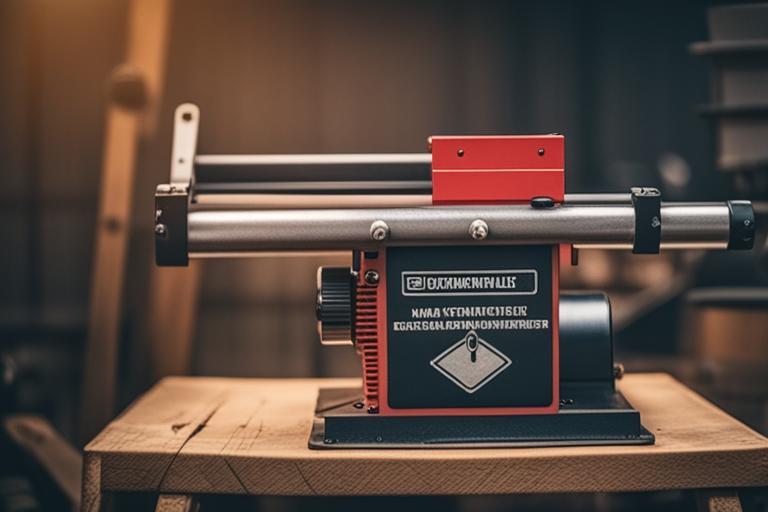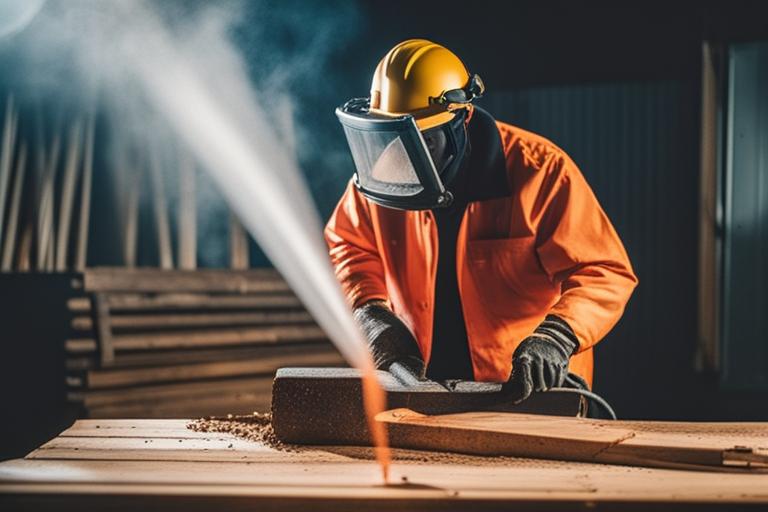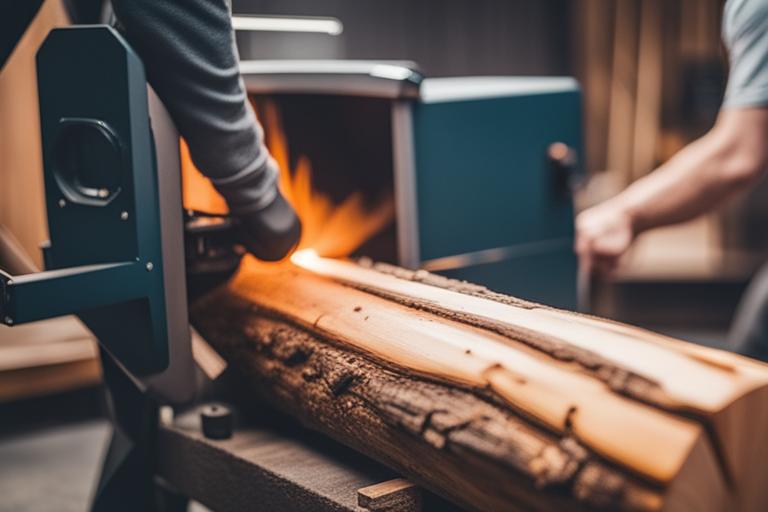If you’re looking to split wood quickly and efficiently, a log splitter is the perfect tool for the job. Whether you’re using a manual, electric, or hydraulic log splitter, safety should always be your top priority. In this article, we’ll discuss the potential dangers of log splitters, the safety features that can prevent accidents, common injuries and how to prevent them, proper use of log splitters, required safety gear, training for safe log splitting, and answer the question “Are log splitters dangerous?”
How to Safely Use a Log Splitter
- Log splitters can be dangerous if not used properly
- There are different types of log splitters with varying safety features
- Proper use of safety gear and training can prevent injuries
Types of Log Splitters
There are three types of log splitters: hydraulic, electric, and manual. Hydraulic log splitters are the most common type and are powered by a gas engine or an electric motor. These splitters have the highest splitting force and can handle larger logs. Electric log splitters are smaller and less powerful than hydraulic splitters, making them perfect for smaller logs. Manual log splitters are the least expensive and rely on human power to split logs. While manual splitters are the safest option, they are also the slowest and require the most physical effort.

Potential Dangers of Log Splitters
Log splitters are powerful machines that can cause serious injury or even death if not used properly. The most common risks associated with log splitters include hand and finger injuries, eye injuries, and back injuries. Accidents can occur due to operator error, mechanical failure, or lack of proper safety features.

Safety Features of Log Splitters
Log splitters come equipped with safety features designed to minimize the risk of injury. Automatic shut-off switches are one of the most important safety features of log splitters. These switches turn off the machine when the operator’s hands are not on the controls. Two-handed operation is another safety feature that ensures the operator keeps both hands away from the splitting area. Safety guards are also included on most log splitters to prevent wood from flying out of the machine.

Common Injuries and How to Prevent Them
Hand and finger injuries are the most common injuries associated with log splitters. These injuries occur when the operator’s hands come into contact with the splitting area. Eye injuries can also occur when wood chips fly into the operator’s eyes. Back injuries are another risk associated with log splitters due to the physical strain of lifting and moving logs. To prevent these injuries, operators should always wear gloves, eye protection, and sturdy shoes. It’s also important to position the wood properly, maintain the machine, and follow the owner’s manual for safe operation.
Proper Use of Log Splitters
To use a log splitter safely, position the wood so that it’s stable and won’t roll or shift during splitting. Next, operate the splitter using the two-handed method and keep your hands away from the splitting area. After splitting the wood, shut off the machine and remove any loose wood chips or debris. Finally, maintain the machine by keeping it clean, lubricated, and properly stored.

Safety Gear Needed for Log Splitting
In addition to proper use of the machine, it’s important to wear the right safety gear. Eye protection is essential to prevent wood chips from flying into the operator’s eyes. Gloves can protect the hands from injury and provide a better grip on the logs. Sturdy shoes are also important to provide traction and protect the feet from falling logs.
| Safety Gear | Description |
|---|---|
| Eye protection | Essential to prevent wood chips from flying into the operator’s eyes |
| Gloves | Protect the hands from injury and provide a better grip on the logs |
| Sturdy shoes | Important to provide traction and protect the feet from falling logs |
Reasoning: This table provides a clear and concise summary of the safety gear needed for log splitting, which is discussed in the section above. It lists the three essential items of protective gear and their main purpose.
| Training Resources | Description |
|---|---|
| Owner’s manual | Provides information on safe operation and maintenance |
| Online tutorials | Offer step-by-step instructions on safe log splitting |
| In-person classes | Provide hands-on training and opportunities to ask questions |

Training for Safe Log Splitting
Proper training is essential for safe use of log splitters. Most accidents occur due to operator error, making training an important part of preventing accidents. Training resources can include the owner’s manual, online tutorials, or in-person classes.
Personal Story: The Importance of Safety Gear
When I first started using a log splitter, I didn’t think much about safety gear. I figured as long as I was paying attention and being careful, I wouldn’t need anything else. That changed pretty quickly.
One day, I was splitting a particularly gnarly log when a piece of wood flew up and hit me in the eye. It was painful and scary, and I knew right away that I needed to take safety more seriously.
After that incident, I invested in a good pair of safety glasses and some sturdy work gloves. It made a huge difference. Not only did I feel more protected, but I was also more confident when using the log splitter. I wasn’t as worried about getting hurt, so I could focus more on the task at hand.
Now, I never use the log splitter without proper safety gear. I’ve even started wearing steel-toed boots for added protection. It might seem like overkill, but I know firsthand how important it is to be prepared for anything.
If you’re new to log splitting, take it from me: don’t skimp on safety gear. It’s worth the investment to protect yourself from potential injuries.
Pros and Cons of Using a Log Splitter
Pros
- Split logs quickly and efficiently
- Reduces physical strain on the body
- Can handle larger logs than manual splitters
- Can increase productivity
Cons
- Can be dangerous if not used properly
- More expensive than manual splitters
- May require more maintenance than manual splitters
- May not be suitable for small or irregularly shaped logs
FAQ
Are log splitters dangerous?
Yes, log splitters can be dangerous if not used properly. The most common risks associated with log splitters include hand and finger injuries, eye injuries, and back injuries. However, by following safety guidelines and using the right safety gear, operators can safely use log splitters to split wood quickly and efficiently.
What safety gear is needed for log splitting?
Eye protection is essential to prevent wood chips from flying into the operator’s eyes. Gloves can protect the hands from injury and provide a better grip on the logs. Sturdy shoes are also important to provide traction and protect the feet from falling logs.
What are the different types of log splitters?
There are three types of log splitters: hydraulic, electric, and manual. Hydraulic log splitters are the most common type and are powered by a gas engine or an electric motor. These splitters have the highest splitting force and can handle larger logs. Electric log splitters are smaller and less powerful than hydraulic splitters, making them perfect for smaller logs. Manual log splitters are the least expensive and rely on human power to split logs.
How do I use a log splitter safely?
To use a log splitter safely, position the wood so that it’s stable and won’t roll or shift during splitting. Next, operate the splitter using the two-handed method and keep your hands away from the splitting area. After splitting the wood, shut off the machine and remove any loose wood chips or debris. Finally, maintain the machine by keeping it clean, lubricated, and properly stored.
Conclusion
In conclusion, log splitters can be dangerous if not used properly. However, by following safety guidelines and using the right safety gear, operators can safely use log splitters to split wood quickly and efficiently. Remember to always position the wood properly, use the two-handed method, and maintain the machine. By following these safety guidelines, you can avoid injury and safely enjoy the benefits of using a log splitter.
Follow us!!